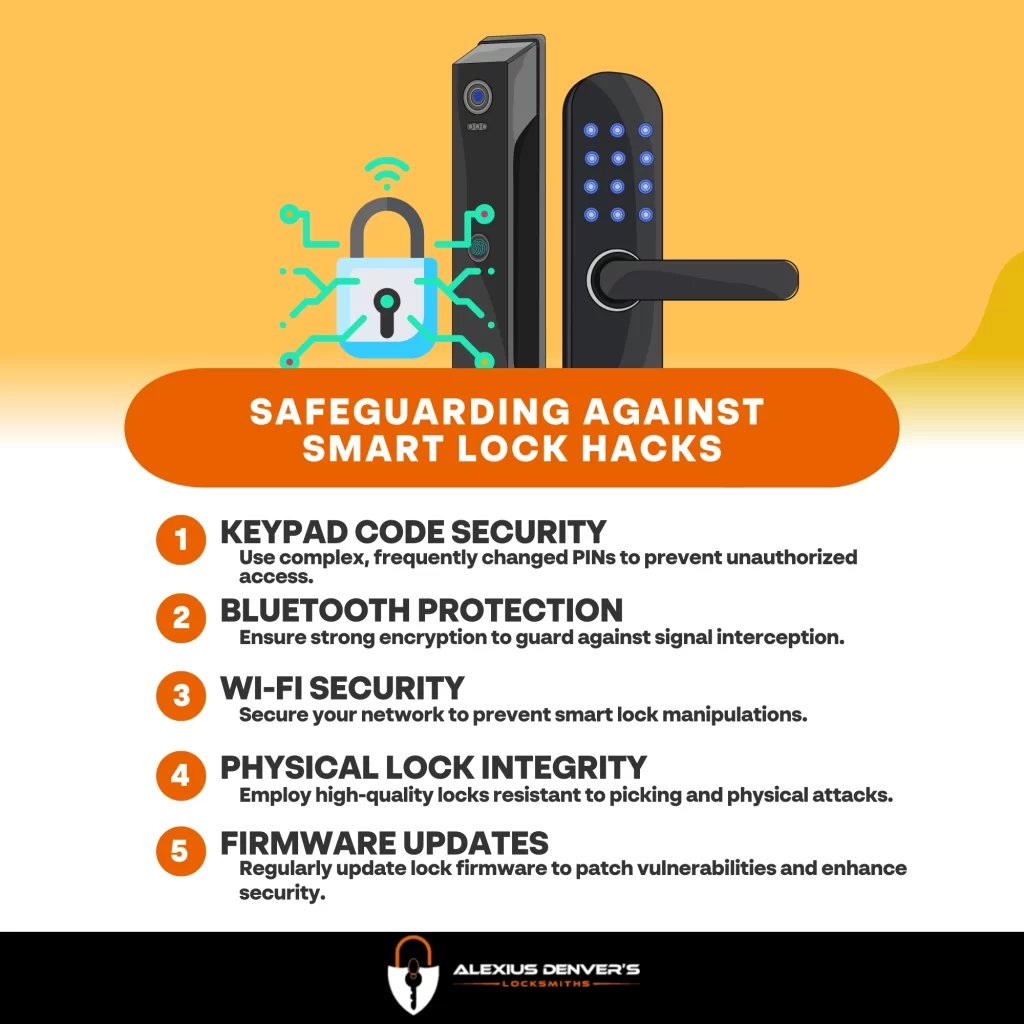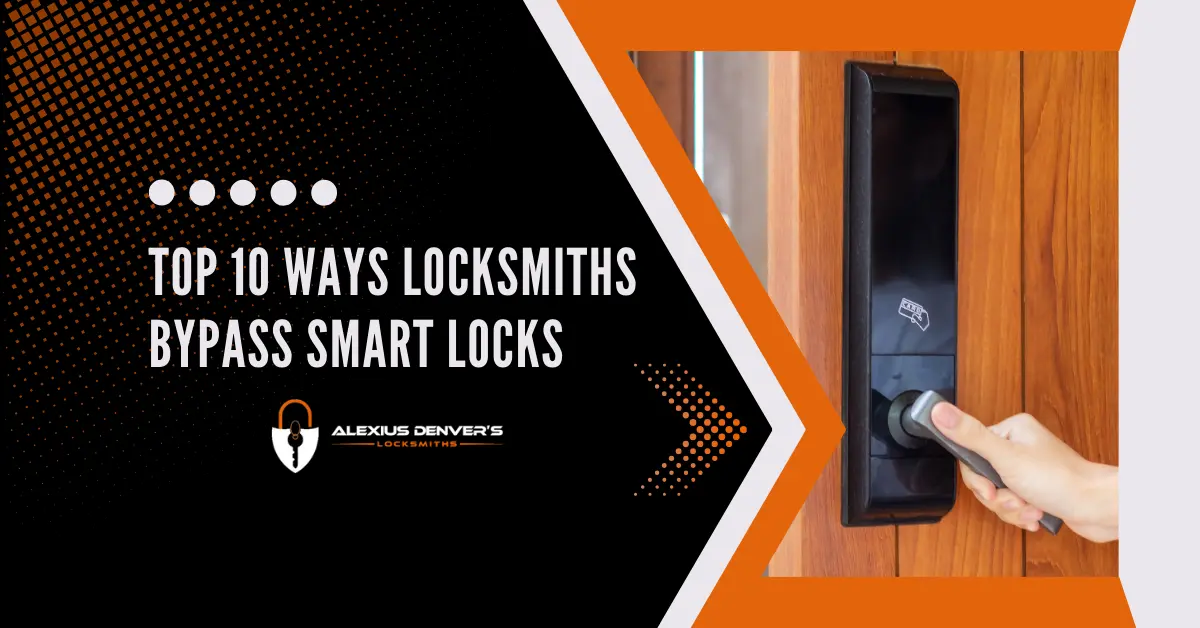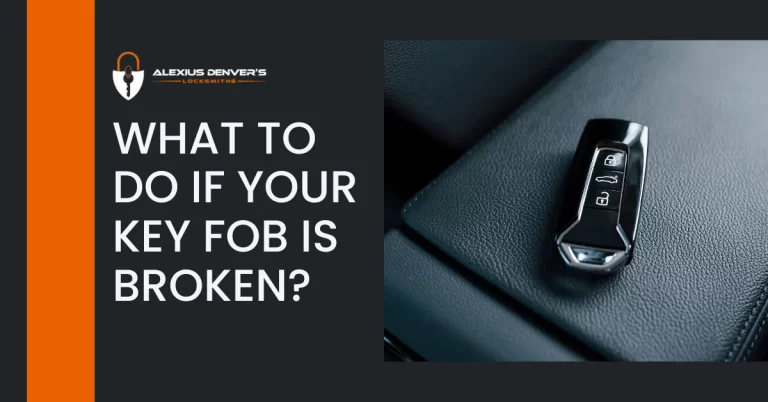Revealing a smart lock’s secrets requires understanding the top techniques locksmiths use. These include keypad code cracking, Bluetooth signal interception, Wi-Fi network exploitation, and RFID tag duplication. Traditional lock picking tools can still work, while firmware vulnerabilities are a significant risk. Side channel attacks and social engineering tricks exploit human error or weak points. Master key systems also present vulnerabilities. Each method varies in complexity, requiring both technical knowledge and risk awareness to counter. By getting acquainted with these tactics, you’ll gain a clearer picture of smart lock security intricacies and how to fortify them effectively.

Key Takeaways
- Locksmiths use keypad code cracking, focusing on weak PINs or default codes to gain access.
- Bluetooth signal interception allows locksmiths to perform man-in-the-middle attacks on smart locks.
- Locksmiths exploit Wi-Fi network vulnerabilities to manipulate smart locks and capture login credentials.
- Physical lock picking techniques, including traditional and advanced digital methods, bypass mechanical and electronic components.
- Battery depletion tricks cause smart locks to malfunction or reset to default settings for easier access.
Keypad Code Cracking
One of the primary methods locksmiths use to bypass smart locks is cracking the keypad code, often exploiting weak or reused PINs. When you engage a smart lock locksmith, they’re equipped with sophisticated tools and techniques to decipher these codes. Weak PINs, like 1234 or birthdates, are easy targets. A smart locksmith near me will often start by analyzing fingerprint patterns on the keypad, revealing frequently used digits.
To mitigate this risk, it’s vital to use a complex, unique PIN. Many users neglect to change default codes, making it simpler for a locksmith smart lock expert to gain access. Regularly updating your PIN and avoiding predictable patterns is fundamental for robust security.
Moreover, some advanced locksmiths can employ software algorithms to determine probable codes based on common user habits. This technique underscores the significance of not only changing your PIN but also making it as random as possible.
Bluetooth Signal Interception
Beyond the vulnerabilities of keypad codes, Bluetooth signal interception poses a significant threat to smart lock security allowing sophisticated attackers to capture and exploit wireless communications between your smartphone and the lock. When you use a smart lock, the Bluetooth signal exchanged carries vital authentication data that, if intercepted, can be replicated to gain unauthorized access to your property. This interception can occur when an attacker uses specialized equipment to eavesdrop on the Bluetooth communication.
To protect against this, it’s important to understand how a smart lock locksmith might exploit these weaknesses. Bluetooth signals are susceptible to man-in-the-middle attacks, where an attacker intercepts the signal, modifies it, and then forwards it to the lock, effectively bypassing security protocols. This is why you should verify that your smart lock employs strong encryption and secure pairing methods.
When searching for a “smart locksmith near me” or a “digital locksmith near me,” find professionals who are knowledgeable about these vulnerabilities and can offer robust security solutions. Regularly updating your lock’s firmware and avoiding using default settings can mitigate these risks, making sure your smart lock remains secure from such sophisticated attacks.
Wi-Fi Network Exploitation
Wi-Fi network exploitation represents a critical vulnerability in smart lock systems, enabling attackers to infiltrate your home network and gain control over connected devices. When an attacker gains access to your Wi-Fi network, they can potentially manipulate your smart locks, bypassing security measures without physical interaction.
A proficient smart lock locksmith understands these vulnerabilities and can offer guidance on securing your network. Wi-Fi networks are usually the backbone of smart home systems, making them an attractive target for attackers. They use techniques such as man-in-the-middle attacks, where the hacker intercepts communication between your smart lock and the network. By doing this, they can capture login credentials or encryption keys, granting unauthorized access.
If you’ve ever searched for a ‘smart locksmith near me’ or ’digital locksmith near me,’ you’re likely looking for someone skilled in both physical and digital security aspects. These experts can suggest robust security practices, like using strong, unique passwords, enabling WPA3 encryption, and regularly updating firmware.
Being aware of these risks and taking preventative measures can help you safeguard your smart lock system against Wi-Fi network exploitation, guaranteeing that your home remains secure from digital intrusions.
RFID Tag Duplication
While securing your Wi-Fi network is fundamental, another notable vulnerability in smart locks is the potential for RFID tag duplication. RFID tags, commonly used for smart lock authentication, can be easily duplicated with the right tools. A smart lock locksmith with technical proficiency can clone these tags by intercepting the radio frequency signals they emit. This process involves using ,RFID readers and writers which are readily available and often inexpensive.
To mitigate this risk, you should be aware of the limitations of your RFID-based smart lock. Opt for devices that use encrypted RFID tags, as they provide an additional layer of security. Regularly updating your smart lock’s firmware can also help patch vulnerabilities that could be exploited by a smart locksmith near me.
Moreover, always be cautious of where and how you use your RFID tags. Avoid placing them in easily accessible or predictable locations. When you suspect any compromise, immediately consult a locksmith smart lock specialist to evaluate and improve your security setup. By understanding these risks and taking proactive measures, you can markedly reduce the chances of unauthorized access via RFID tag duplication.
Lock Picking Techniques
When considering lock picking techniques, you’ll find that locksmiths utilize both traditional picking tools and advanced digital methods. Understanding these methods is essential for evaluating the security risks associated with smart locks. Awareness of how these techniques are employed can help you identify potential vulnerabilities in your own security systems.
Traditional Picking Tools
Despite advancements in smart lock technology, locksmiths often rely on traditional picking tools to exploit vulnerabilities within the mechanical components of these devices. When you ask, ‘can a locksmith open a deadbolt?’ the answer often lies in their proficiency with these conventional tools. Even the most advanced smart locks usually incorporate a conventional deadbolt mechanism, creating an opportunity for a smart lock locksmith to employ traditional picking methods.
Locksmiths use tension wrenches and pick tools to manipulate the internal pins of the lock. By applying subtle rotational pressure with the tension wrench and skillfully lifting the pins with the pick, they can gain access to the device without causing damage. This method remains effective because, despite digital improvements, the mechanical components have not dramatically evolved.
If you’re searching for a ‘smart locksmith near me,’ it’s essential to evaluate their expertise with traditional tools. While technology evolves, the fundamental principles of lock-picking remain relevant. Locksmiths must possess both modern technical skills and a deep understanding of traditional methods to confirm they can address any lock scenario effectively. This dual expertise guarantees that vulnerabilities in even the latest smart locks can be efficiently exploited, highlighting the continued importance of traditional picking tools.
Advanced Digital Methods
In the domain of smart lock security, advanced digital methods have become vital tools for locksmiths to bypass sophisticated electronic mechanisms. When traditional tools fall short, these techniques offer a higher degree of efficacy. As a smart lock locksmith, you’ll often encounter encrypted systems and networked devices that require more than physical manipulation.
One prevalent method is signal interception. By capturing the communication between the smart lock and its associated device, you can decipher the release sequence. This, however, requires specialized equipment and a deep understanding of encryption protocols. If you search for a ‘smart locksmith near me,’ you’ll find experts adept in these advanced techniques.
Another technique involves firmware manipulation. By accessing the lock’s firmware, you can alter its operational code, effectively disabling security features. This method is risky—incorrect manipulation can render the lock inoperable, posing a significant risk.
Brute force attacks are also employed, though less frequently. They involve overwhelming the lock’s system with numerous access attempts, potentially revealing vulnerabilities. While effective, it’s time-consuming and can trigger security alerts.
Incorporating advanced digital methods guarantees you’re prepared for any smart lock challenge. Just remember, each technique carries its own risks and requires a high level of technical proficiency.
Brute Force Attacks
When it comes to brute force attacks, understanding the physical vulnerabilities of smart locks is essential. You should also be aware of battery depletion tricks and how signal interference methods can compromise security. These techniques highlight inherent risks that can render even the most advanced smart locks susceptible to unauthorized access.
Physical Vulnerabilities Exploited
Locksmiths often exploit physical vulnerabilities in smart locks by employing brute force attacks, which can compromise the lock’s structural integrity and bypass its security mechanisms. When you search for a ’smart lock locksmith’ or ‘smart locksmith near me,’ you’re likely looking for someone who understands these vulnerabilities. Smart locks, while technologically advanced, often have weak points in their physical construction that can be targeted.
A locksmith smart lock expert knows that forceful techniques, such as hammering or prying, can exploit these weaknesses. Poorly designed locking bolts, inferior materials, or inadequate mounting can make a smart lock susceptible to such attacks. In some cases, a persistent force can misalign the internal components, leading to the lock malfunctioning and opening.
You should be aware that this method isn’t subtle and may leave visible evidence of tampering. However, the effectiveness of brute force attacks often depends on the quality of the smart lock in question. High-end models typically employ more robust materials and advanced design principles to resist such methods. Consequently, conducting thorough research and investing in a high-quality smart lock can mitigate the risk of brute force vulnerabilities being exploited by a locksmith.
Battery Depletion Tricks
Beyond exploiting physical vulnerabilities, another common method involves draining the smart lock’s battery to force a malfunction or system reset. This technique capitalizes on the reliance of smart locks on battery power, which, when depleted, can lead to a temporary or permanent shutdown. A smart lock locksmith might intentionally trigger repeated access attempts, causing the lock to consume more power than usual.
When you search for a ‘smart locksmith near me,’ you expect expertise not just in traditional locks but also in sophisticated smart systems. These professionals understand that many smart locks enter a default state when battery levels are critically low, often reverting to a factory reset or granting access to prevent lockout. This is a security flaw that can be exploited.
Signal Interference Methods
Signal interference methods, including brute force attacks, exploit the inherent vulnerabilities in the wireless communication protocols of smart locks. These methods can disrupt the signals between your smart lock and its paired device, effectively rendering the lock temporarily useless. A smart lock locksmith might use specialized tools to jam or interfere with these signals, forcing the lock into a state where it can be manually manipulated or reset.
When you’re searching for a ‘smart locksmith near me’ or a ‘digital locksmith near me,’ it’s vital to be aware of how these interference techniques work. Brute force attacks, in particular, can involve bombarding the lock with numerous signals to overload its system. This approach targets the lock’s ability to process incoming data, often leading to a malfunction or a forced reset, which can then be exploited to gain access.
Risk awareness is key. While smart locks offer improved security features, their reliance on wireless communication opens up avenues for sophisticated attacks. Understanding these risks can help you better secure your smart lock system and make informed decisions when consulting a professional locksmith. Always verify your smart lock has up-to-date firmware to mitigate some of these vulnerabilities.
Firmware Vulnerabilities
Firmware vulnerabilities often serve as a vital entry point for bypassing smart locks, exposing them to unauthorized access and manipulation. When you’re searching for a ‘smart lock locksmith’ or a ‘smart locksmith near me,’ understanding these vulnerabilities can be essential for both security and convenience. Hackers or even a locksmith smart lock expert can exploit outdated or poorly written firmware to gain control over your smart lock.
Firmware acts as the operational brain of your smart lock, and when it’s not regularly updated, it can become a weak spot. Exploiting these vulnerabilities usually involves reverse-engineering the firmware to identify flaws that allow unauthorized access. For example, some smart locks may have hard-coded backdoor passwords or insufficient encryption, making them susceptible to brute-force attacks.
Side Channel Attacks
Often overlooked, side channel attacks exploit indirect information leaks to bypass the security mechanisms of smart locks. These attacks don’t directly target the encryption or authentication process but rather focus on physical emanations or timing information to uncover vulnerabilities. For instance, a smart lock locksmith might analyze power consumption patterns or electromagnetic emissions to extract the cryptographic keys used by your smart lock. This type of attack requires a high level of technical expertise and specialized equipment, making it a formidable risk.
Consider these common side channel attack vectors:
- Power Analysis: Monitoring the power usage of a smart lock to deduce cryptographic operations.
- Timing Attacks: Measuring the time taken for smart lock operations to infer sensitive information.
- Electromagnetic Leaks: Capturing electromagnetic radiation emitted by the smart lock to gather data.
- Acoustic Cryptanalysis: Listening to the sounds produced by the lock’s internal components during operation.
If you’re searching for a ‘smart locksmith near me,’ ascertain they are aware of these sophisticated attack methods and can offer robust countermeasures. A competent locksmith smart lock professional will understand these risks and recommend appropriate safeguards to protect your smart lock from side channel attacks. Your security depends not just on the lock itself but on the expertise of the locksmith you choose.
Social Engineering Tricks
Social engineering tricks exploit human vulnerabilities to gain unauthorized access to smart locks, often bypassing sophisticated technical defenses with alarming ease. By manipulating human behavior, a smart lock locksmith can employ tactics like pretexting, phishing, or even impersonation. These methods don’t require extensive technical knowledge but are highly effective at compromising security.
Imagine you’re searching for a “smart locksmith near me” and you receive a call from someone claiming to be a technician from a well-known company. They might ask for your smart lock’s serial number or request remote access to troubleshoot an alleged issue. In reality, they’re setting the stage to exploit your trust.
A common ploy involves the locksmith pretending to be a resident or maintenance worker. They might engage in casual conversation to glean information about your security habits. With a few well-placed questions, they could learn enough to bypass the lock’s security features.
Digital locksmiths near me can also leverage social media and online platforms to gather personal data. By piecing together information from various sources, a social engineer can create a convincing narrative to deceive you. Always be skeptical and verify identities through multiple channels to mitigate these risks.
Master Key Systems
While social engineering preys on human vulnerabilities, master key systems exploit inherent design weaknesses in smart locks to gain access without triggering alarms or alerts. These systems are designed to allow a single key to open multiple locks, offering convenience but also presenting significant security risks. If a smart lock locksmith can obtain or fabricate a master key, they can potentially bypass your smart lock’s defenses.
Master key systems can undermine the integrity of your smart lock setup in several ways:
- Key Duplication: A smart locksmith near me can duplicate a master key with specialized equipment, allowing unauthorized access.
- Key Impressioning: This technique involves creating a master key by analyzing the wear patterns on a lock, which can be done discreetly.
- Master Key Charting: Smart locksmiths can create a chart to decode the master key system, effectively mapping out which key opens which lock.
- Exploiting Manufacturer Backdoors: Some smart locks have built-in backdoors for master key access, which skilled locksmiths can exploit.
Understanding these vulnerabilities underscores the importance of employing advanced security measures. Always verify that your smart lock system is audited by a reputable locksmith smart lock professional to mitigate these risks effectively.
Conclusion
In summary, understanding how locksmiths can bypass smart locks is like having a double-edged sword; it arms you with both the knowledge to safeguard your home and the awareness of potential risks. From cracking keypad codes to exploiting firmware vulnerabilities, each method underscores the importance of robust security measures. Stay vigilant and continually update your systems to keep one step ahead of potential breaches. Your home’s security is only as strong as its weakest link.






